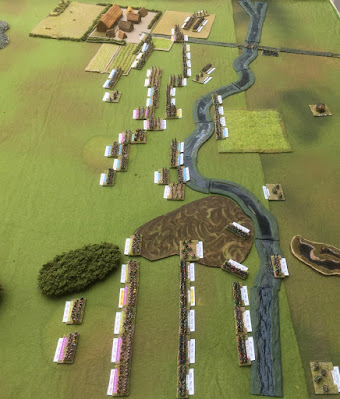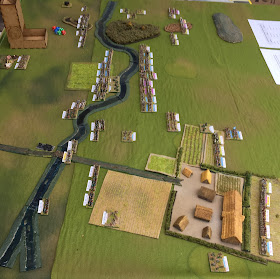The Pictish Forces are advancing from the North East and near an insignificant settlement called An Cladach they clash with the Dal Raitian royal army. The Dal Raitian Scots are defending and the invading Picts are being run by the AI rules. I am again using De Bellis Solitarius
which are available as a free download from the Fanaticus and other, websites. Versions are available for DBA 2.0 and 3.0 and I find that they give an interesting game by virtue of setting constraints on what the AI side is allowed to do while allowing player input within those constraints. Before the game started I decided on the Scots deployment. I then rolled up the Picts overall tactical stance for the encounter and then their deployment. Think of that as the commanders pre-battle briefing from the CinC something like:"Right settle down and listen up, here is the plan. We outnumber them almost two to one so they either have to hit us hard and fast before we have the line properly set up or they will want to defend and use the ground to their advantage. If they attack their initial charge is a problem but if we stack the spearmen deep we should be able to absorb the impact.
Moravin, you have the larger command so act aggressively, I'm putting you out on the right flank with Mar. You have the majority of the mounted lads so if you get a chance to get around their flank, take it. Especially if you see a chance to attack their camp. Nothing like having your women attacked to take a man's mind off the fighting eh?
I will be in the centre with the rest of the Army, so that's you three, Strath Erin, Athfotla and Monath. Your boys will hold the centre and cover our camp. Nothing too clever required there, I think we can hold back in a defensive posture and see how things develop on the right. If they attack us then all the more space on the flank for the mounted lads to use. I'm pretty sure their entire strength is in the field against us but I'm not ignoring the risk of them trying to land behind our flank from boats. Moravin the beach is on your flank so have a think about about what you might do to cover that eventuality will you.
Everyone happy? Excellent well grab what sleep you can and we shall see what the morning brings."
Or as the dice rather more prosaically gave me; place the camp as near the centre line as possible and behind any available bad going. Command 1 (The King with 8 elements) deploy in the centre with a defensive stance. Command 2 (11 elements) deploys on the right flank and takes an aggressive stance. Pike form up two deep if facing warbands. Fastest troops deploy on the end of the line.
The Scots have 11 elements to deploy including the King. There is nothing to loose and a defensive strategy just will not cut it. The Scots will probably never have more men in the field than they have today, so they have to take the fight to their Pictish cousins. Accordingly I have decided to go with a littoral landing. That will be on the Pictish Right which it turns out are under orders to be aggressive and so with any luck it will land behind their flank.
The Scots briefing is an altogether more downbeat affair.
'Alright then sit down and take a drink it may be the last one you get from me. You all know the Picts outnumber us and have a point to prove having had a beating from the Strathclyders of late. They have crossed the mountains to get at our heartlands so I doubt they just want to talk. Tomorrow is going to be bloody, the only question is whose blood will be on the heather?
We don't have the luxury of giving up this ground and there are no reinforcements coming. What we do, win or loose, we do with the men we have, here, at this place. They will come on fast and that is our one advantage as it will give us the option of turning their flanks. I will have the main body but you Comgail, you will lead a small group to land on the beach behind them. Hit them in the flank or rear and hit them hard. Make them rue the day they came to Dal Raitia. You will be the hammer, we will be the anvil and between us I intend to crush them. Now go see to your men, tell them of certain victory on the morrow and, remind them that they are fighting for their homes and families.
The Day of Battle
'The day of battle dawned and looked set fair so the fight commenced almost immediately. Our landing party sprang into action as soon as the Picts were in reach and charged up the beach into the end of their line. Two units of Pictish light horse turned to meet the threat. Meanwhile our main line advanced as quickly as they could but it was clear that the landing party would be on their own for a wee while. We could tell that the attack from the beach had the Picts rattled as their advanced stopped dead on that flank.'
 |
1. The armies deployed -landing party ready to storm up the beach!
|
A good opening pip score allows the out of command littoral landing to get into contact with the end of the Pictish line. In their turn both Pictish commands get abysmal pip scores and low aggression scores meaning that the right hand command who are meant to be moving up stall as their flank units have to deal with the Scottish attack. The left hand command does manage to advance to occupy the boggy ground to their front. This was repeated for the next two turns where the Picts consistently rolled single pips for both commands.
'We couldn't believe that the beach attack had thrown the enemy into such confusion, we could see that the fighting was muckle fierce on that flank and one group of Pictish light horse was soon destroyed. The rest of that wing seemed incapable of reacting to the attack. Our main body continued to push forward towards the enemy with our wilder tribesmen leading the advance.'
 |
2. Picts in a pickle - down one LH already
|
I roll two dice for each Pictish command the large dice is the aggression for this turn the smaller the Pip score. The aggression roll is adjusted based on the starting aggression and the pip score. The photo below shows just how bad the Pictish rolls were!
 |
| 3. On the defensive. Awful dice mean the Picts cannot put attacks together! |
As the day rolls on the landing party takes out a second light horse unit it had pinned back against the end of the Pictish line. The poor Pictish command rolls are really hurting them and the right wing is only one unit away from becoming demoralised.
 |
4. It looks better than it really is for the Picts (on the left here)
|
The terrain is helping the Scots. The aggressive Pictish right wing has to overcome the flanking attack and get through the woods to to turn the Scot's left. The other flank, which is wide open, is facing the defensive Pictish wing who are less likely to take advantage. The boggy ground is doing nothing to slow either side but it is preventing the Pictish spearmen gaining the rear support bonus Fast Pike would gain in clear terrain.
 |
5. The Scots have a decent defensive line at least
|
It isn't until turn five that the Picts get a decent pip and aggression roll and with the Scots racing forwards to the attack with their main force it isn't a moment too soon. They bring more troops up to the fight on the right wing and push forwards in the centre where the two lines come to close combat. There the fighting leads to a first casualty for the Scots and the usual confusion as the neat lines dissolve. At this point you would have thought that things are about to improve for the Picts, they are in contact all along the line and should be able to bring the advantage of numbers to bear. You might have thought that but, the dice gods really have it in for the painted people and in the first combat they loose another unit. Even worse this is from their right wing command which pushes them over the edge into demoralisation. There is a single ray of hope now as a second scots unit was destroyed in the combat round, so the Scots are edging closer to their break point.
 |
6. A turn later and the battle is slipping away from the Picts
|
The next couple of turns have the Picts attempting to keep their right wing on the table by using pips to force unit's hold their ground. Because they are demoralised that wing can't do anything but hold or retreat and it takes a pip to have a unit hold in place, they can't initiate combat although they can defend. Their biggest problem is that if they hold the units closest to the edge of the table in place then those who are pinning the Scot's beach landing in place have to retreat and that opens the way for a camp run. On the other wing I successfully override the standing orders for a turn and send a Pictish light infantry unit sprinting for the Scot's camp but with my Scot's cap (should that be bonnet?) on I counter that with a Scots light infantry unit in the following turn by bringing close enough to pin the Picts in their threat zone.
 |
7. Although the Picts' left is holding men a streaming to the rear on the right wing
|
Things are looking bleak for the Picts now as the only command that can act has defensive standing orders so is going to struggle to advance to combat. Poor dice rolls on the other wing are allowing units to head to the rear there. Although the Pict's have managed to get into a good position for an attack the defensive stance stops them from capitalising on it and I failed the override dice roll for them. A poor pip roll for the demoralised command sees four elements leave the table and that is game over.
Although not particularly heavy, the losses will have an impact on both sides the Picts have lost three elements and the Scots two. At least the King of Picts was able to escape the disaster.
The Pictish chronicles simply recounts
'The fury of the Scotsmen knew no bounds'
This game taught me a few things about these troops. Fast pike are capable troops but only if well deployed the +3 rear support bonus would have made a huge difference had I been able to use it. It was only the poor initial deployment that worked against them and I should have redeployed the line to get them into good going. The terrain made no difference to movement for the infantry as both sides have fast foot or solid auxilia who are not slowed in bad going. Still the Picts are not going to let a little thing like two defeats in one turn change their ambition and they will be be back.











































